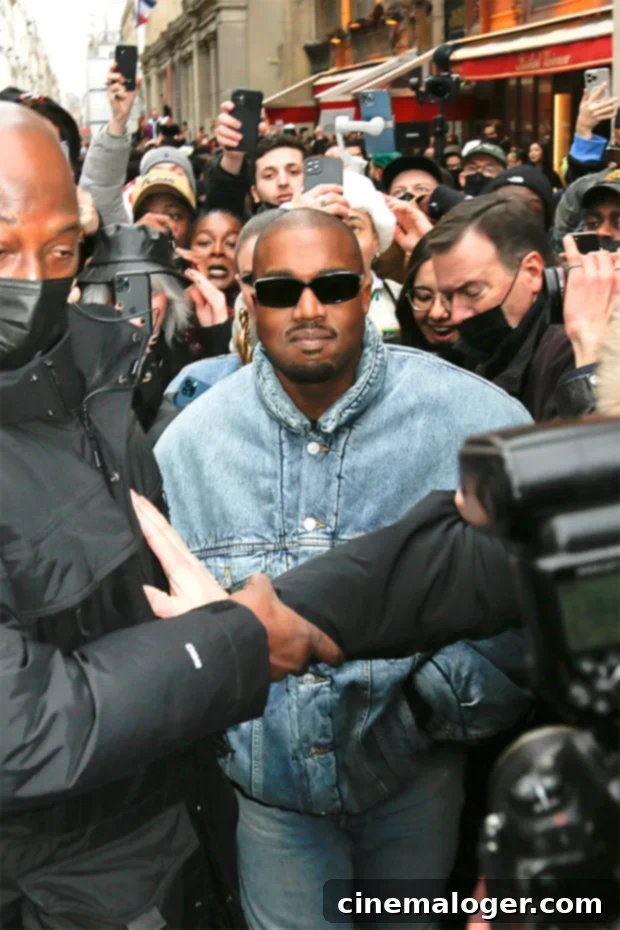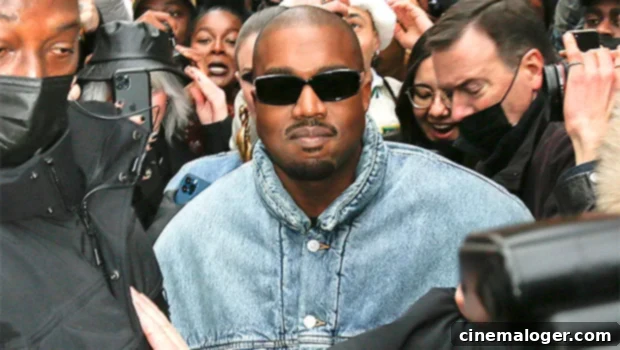Kanye West’s Donda 2: An Exclusive Album Experience on the Stem Player – Breaking Down the $200 Price Tag and Fan Reactions
In a move that sent ripples throughout the music industry and sparked intense debate among fans, Kanye West, also known as Ye, announced that his highly anticipated album, Donda 2, would not be available on conventional streaming platforms. Instead, the only way to experience the album upon its release would be through the purchase of his innovative hardware device, the Stem Player, priced at $200. This declaration, made on February 17, shifted the conversation from his personal life, including ongoing discussions around Kim Kardashian and Pete Davidson, back to his profound impact on music and technology.
Kanye’s bold strategy represents a significant departure from standard album release practices, challenging the established dominance of streaming services and reigniting discussions about artist compensation and control. His announcement, delivered via Instagram, clearly laid out his vision: “Donda 2 will only be streaming on my own platform, the Stem Player. You can download new music from StemPlayer.com. You can play four different elements of the track: vocals, drums, bass and music. It also has a MP3 player available. We currently have 67,000 available and are making 3,000 a day.” This statement set the stage for one of the most polarizing album rollouts in recent memory, forcing fans to decide between investing in a new piece of hardware or potentially missing out on new music from one of the most influential artists of his generation.
View this post on InstagramA post shared by ye (@kanyewest)
The Stem Player: A Closer Look at Kanye’s Innovative Music Platform
The Stem Player is not merely a device for listening to music; it’s an interactive gadget that Kanye West actively helped to create and promote. This portable audio device, developed in collaboration with Kano Computing, offers a unique way for users to engage with music. Its core functionality lies in its ability to “stem” tracks, meaning it can isolate and allow manipulation of individual components such: vocals, drums, bass, and other instrumental elements. This innovative feature transforms the listening experience from passive consumption to active participation, enabling fans to remix and customize songs in real-time. Beyond its advanced stem-separation capabilities, the Stem Player also functions as a standard MP3 player, offering versatility for everyday use.
The decision to make Donda 2 exclusive to the Stem Player means that acquiring the album comes with an upfront cost of $200 for the device itself. Kanye’s update specified that 67,000 units were initially available, with an additional 3,000 being manufactured daily. This controlled distribution model, combined with the substantial price point, immediately created a significant barrier for many fans. While some viewed it as an exciting new frontier for music interaction, others saw it as an expensive and exclusionary tactic, limiting accessibility to a dedicated — and financially capable — segment of his fanbase. The limited supply also added an element of urgency and exclusivity, reminiscent of luxury product launches rather than traditional album releases.
Kanye’s Stance on the Music Industry: A Call for Artist Freedom
Kanye West articulated his reasons for eschewing traditional streaming platforms in another impassioned Instagram post. His core argument revolved around the perceived injustice in artist compensation within the current music industry ecosystem. “Today, artists get just 12 percent of the money the industry makes,” he wrote, exposing a widely criticized aspect of modern music distribution. This stark figure highlighted his belief that streaming services, while offering unparalleled reach, disproportionately benefit platforms and record labels rather than the creators of the music itself. For Kanye, this was not just a business decision; it was a crusade to “free music from this oppressive system” and empower artists to “take control and build our own” platforms.
Kanye’s move can be seen as part of a long lineage of artists challenging established industry norms, reminiscent of Prince’s battles for creative control and independent distribution decades ago. By creating a direct-to-fan hardware channel, Kanye aims to bypass intermediaries and establish a more equitable revenue stream for himself and potentially other artists who might adopt a similar model. This philosophy taps into a growing sentiment among musicians who feel marginalized by low royalty rates and a lack of transparency from streaming giants like Apple Music, Amazon Music, Spotify, and YouTube. His actions raise critical questions about the future of music distribution: could this model spark a broader movement towards artist-owned platforms, or will it remain an outlier due to its inherent limitations in reach and accessibility?

Fan Reactions: A Divided Audience and the Piracy Dilemma
The announcement of Donda 2‘s Stem Player exclusivity elicited a wide spectrum of reactions from Kanye West’s global fanbase. While a segment of fans lauded his innovative vision and commitment to artist autonomy, viewing the Stem Player as a revolutionary step forward, a significant portion expressed frustration and outrage. Many supporters applauded Kanye for challenging the “oppressive system” of streaming and for offering a novel, interactive way to consume music. They appreciated the artistic control and direct connection to the artist that this model promised, framing it as a necessary evolution for the industry.
However, the $200 price tag proved to be a major sticking point for a vast majority. The cost was prohibitive for many, especially younger fans or those facing economic constraints. Social media platforms quickly became a battleground for opinions, with countless tweets and posts lambasting the decision. “Kanye, I am not spending $200 for Donda 2,” one person tweeted, articulating a common sentiment. “I’ll find that s*** online.” This response highlighted the immediate consequence of such a high barrier to entry: a surge in discussions about album leaks and piracy. Another fan lamented, “Guess I ain’t listening to Donda 2,” while yet another declared that Kanye “has lost his godd*** mind” for making such an exclusive release. The exclusivity forced many loyal fans into a moral dilemma: either pay a significant sum for a new device or resort to unofficial, pirated versions of the album, undermining Kanye’s very goal of fair artist compensation.
Donda 2’s Release: Anticipation, Delays, and Tracklist Teasers
Adding to the fervor surrounding Donda 2, Kanye also teased the album’s tracklist on his Instagram account, further building anticipation for the February 22 release date. The handwritten list, subject to ongoing edits, is a familiar sight for long-time Kanye fans. His penchant for last-minute changes and extensive revisions has become a hallmark of his creative process, keeping fans on their toes until the very last moment. Kanye himself acknowledged this pattern, captioning the tracklist photo with “Like we always do at this time,” a nod to his history of evolving projects right up to their debut.
This history, however, also breeds a certain level of anxiety among his followers. Kanye West is famously known for delaying album releases past their announced dates, sometimes by days, weeks, or even indefinitely. This track record means that despite the definitive release date and the Stem Player announcement, fans remained anxiously vigilant, wondering if Donda 2 would indeed materialize on February 22. The combination of an unconventional release method, a high price point, and Kanye’s unpredictable nature created a unique blend of excitement, frustration, and uncertainty, making the rollout of Donda 2 one of the most talked-about events in recent music history even before a single official stream became available.
Beyond Donda 2: What Does This Mean for the Future of Music?
Kanye West’s decision to release Donda 2 exclusively on the Stem Player is more than just an album rollout; it’s a profound statement and an experiment that could have lasting implications for the music industry. This move forces a reevaluation of the symbiotic yet often contentious relationship between artists, fans, and digital platforms. Is this an isolated, idiosyncratic venture by an artist known for pushing boundaries, or does it herald a potential paradigm shift in how music is consumed and monetized?
For independent artists, Kanye’s gambit offers a fascinating case study in reclaiming control and exploring alternative revenue models. If successful, it could inspire other creators to bypass traditional distributors and forge direct relationships with their audience, potentially leading to fairer compensation and more innovative fan engagement strategies. However, the immense resources required to develop and market a proprietary hardware solution like the Stem Player mean this model is likely beyond the reach of most artists. The challenge for a broader adoption would be finding scalable and affordable ways to replicate the direct-to-fan exclusivity without alienating the majority of potential listeners.
Ultimately, Donda 2‘s exclusive release on the Stem Player highlights the ongoing tension between artistic vision, commercial viability, and fan accessibility. While Kanye’s intent to empower artists is commendable, the execution has created significant debate and potentially limited his album’s reach. The coming months will reveal whether this bold move was a revolutionary step forward for artist independence or a niche experiment that prioritized control over widespread public access, leaving an indelible mark on the ever-evolving landscape of the music industry.
